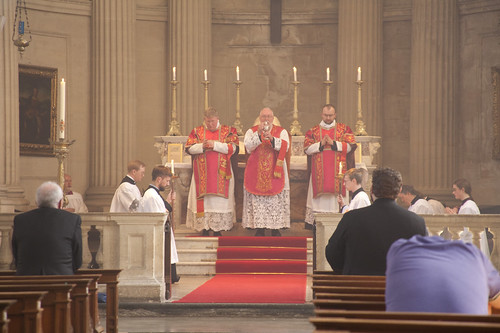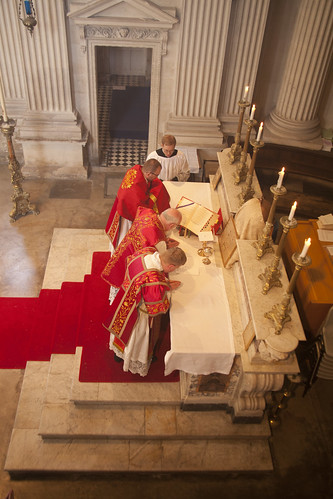
(A pre-scheduled post. Follow me on the Chartres Pilgrimage on Twitter: @LMSChairman )
Thanks to interactions on Twitter and in the comments of this blog, I've learnt a bit more on the history of seating in Catholic churches being segregated by sex. (For my previous post, see here.)
One of the things which has puzzled me about it is that, although recommended in the 1917 Code of Canon Law (Canon 1262.1), I've come across no literary references to segregated seating in churches. But I think that the practice was never re-established in Catholic churches in England after the Reformation; the disruption of having to worship in secret and so on caused the custom to disappear, and it was never something which people felt strongly enough about to make a special effort to restore. (I read in Archer's Two Catholic Churches that eyebrows were raised by some English Catholics at the restoration of such 'Italian' practices as the Asperges before Sunday Mass, in the early 19th century.)
As I've already mentioned, I myself have seen segregated congregations: in 1990, in the Cathedral of Tabora in Tanzania. At that time it wasn't practiced in the commercial capital, Dar es Salaam.
I've now heard from several people in Ireland who can vouch for it surviving in rural districts up to the time of Vatican II, and even later: the 1980s and 1990s. It is worth noting, as several did, that it wasn't enforced: like mantillas today, it just happened, where it was a custom, with the odd person in the wrong part of the church either through ignorance or out of conscious defiance.
Here's a blog post talking about segregation in a church in Nova Scotia, Canada, up to the time of the Council.
I've also heard of churches in the Netherlands with pews featuring hooks for men's hats - only on the 'men's' side.
Finally, it is not surprising to hear that the medieval practice continued in the Church of England for some time after the Reformation. What is rather fun is to hear of an Anglican church where they still maintain it:
He [a guide] explained that two services a month are held in the church using the 1662 prayer book. There is a big congregation. The congregation is still segregated with the men on the right and the women on the left. Even the family sat on separate sides in the front pew. This is slightly larger with more elaborately carved woodwork and a metal latch on the door which could be locked. The cushions are the originals from the 17thC and the family pew has a gold edging round the deep blue cushions.
Unmarried girls and lads sat in the side aisles, and were kept well apart. The back corner of the south aisle was were the stable lads sat and is called 'graffiti corner' as a result of boredom during the service.
This in part reflects the customs which grew up with the installation of pews: family pews and the like. Until the 16th century, when pews began to appear, the location of members of the congregation must have been more fluid.
In the Middle Ages it would seem local customs varied a good deal: there are sometimes separate doors for men and women, and occasionally we hear of women sitting behind the men rather than to one side. In antiquity women were sometimes given a gallery, a 'matronea', and we also hear of physical screens dividing churches lengthways.
The practice is connected with the development of the kiss of peace: actually, in the West, an embrace (amplexio). This could not, obviously, be given between the sexes, unless they were getting married to each other, and this was one reason for it being restricted to those in choir, or being replaced by the Pax Brede, a object kissed by each member of the congregation in turn. (See the Position Paper on the Kiss of Peace.)
 |
| Hans von Tübingen, 15th century |
The painting in fact fits in very neatly with something else: that it was widely believed in the Middle Ages that women were more pious than men, and more likely to be saved. This fact is a little inconvenient for Shulenburg's analysis.
I don't know if there is a connection with the Last Judgement - I suspect Shulenburn just made that up - but I do know that when the celebrant at High Mass turns to face the people, he has the deacon on his right, the Gospel side, and the subdeacon on his left. By the same logic, when I am presenting candidates for their degrees in Oxford University's gloriously medieval degree ceremony, I (and my candidates) bow to the Vice Chancellor seated between two Proctors, then to the Proctor on his right (my left), and then to the Proctor on his left (my right).
 |
| Deacon on the Gospel side, subdeacon on the Epistle Side. |
The eagerness to present any differences between men and women in Christianity as evidence of the oppression of women is seen equally in the debate about alter servers and, of course, about ordination.
 |
| Deacon on the Epistle side, Subdeacon on the Gospel side. |
Making this concession also allows the alleged stupidity of our Christian predecessors to be rolled together with cheap shots at Orthodox Judaism and Islam by people who dislike them, in the last analysis, simply because they are religions. To develop a point I have made before on this blog, we should never let our worries about Islam betray us into a mode of criticism of it which says that Catholics are only slightly less bad. Islam is certainly open to criticism, including in what it has to say about women. At any rate, unlike Medieval Catholics, Muhammad claimed (as recorded in the most authoritative Hadith, Sahih Bukhari) that more women are in Hell than men. But separating men and women in worship is simply a tradition Islam has in common with the other Abrahamic religions.
In the late 1970s, when I moved with my parents and siblings from Dublin to a rural parish, this segregation was generally still practised. Regretfully, I didn't appreciate it then, and contributed to its demise over the next few years (though many older members of the congregation would have maintained their traditional side of the church.
ReplyDelete...we are conceding that the Church has been wrong in her most sacred and intimate moments, in her worship; that her worship, over centuries and even millennia, and all over the world, has been invaded by stupidity, hatred, and prejudice."
ReplyDeleteBut this is, in fact, what many progressives in the Church really *do* believe, including so many of our professional liturgist friends. At best, they dismiss it as a Rahnerian or Tielhardian evolution, perhaps, but even so it surely must trigger some cognitive dissonance for some. But that can hardly be the only discipline or doctrine of which that must be true.
I think reviving this ancient and longstanding practice would be a nonstarter in virtually all traditional communities, at least in North America; but it would be intriguing to see one make a real go of it. I would be curious to learn of its history, to the extent that it exists, as a practice in American Catholicism.
Athelstane,
ReplyDeleteI fully agree that it would be very intriguing to attempt to introduce this to a "traditionalist" chapel in the US of A. I imagine that it would go nowhere, as most trads' conceptions of tradition are not all that Traditional.
I would also surmise that this was practiced much less in the States than elsewhere, especially owing to the rampant Americanism of the powerful Irish bishops and the desire of most Catholics to simply fit in as "normal Americans" amongst their protestant neighbors and culture. If Catholics had been serious about standing up for the fullness of the Faith, they had the numbers to seriously challenge the Enlightenment-protestant USA in the early-to-mid 20th century.
I imagine that it would go nowhere, as most trads' conceptions of tradition are not all that Traditional.
ReplyDeleteI think most trads are picking through the rubble of tradition and trying to make what they can of the ruins with little guidance - some allowance must be made for the extraordinary nature of the situation.
There's the older generation for whom there is still the vestigial childhood memory of what it was like in the last years before it all got dismantled - the 50's and early 60's. Which was a time in which, indeed, the deformations had already begun creeping in. A friend calls them "1958 men." I think that's who you have in mind. But for younger ones, for whom there is no such memory (like me!), they must simply figure it the hard way, often with little resources and considerable restrictions. This month I've been helping successfully start up a daily TLM at a dying African-American parish which had been run by very liberal pastors for decades; there is surprising enthusiasm, but we're rebuilding a tradition literally from scratch, and it's a fair question how much we can throw at them at once. Fortunately, head coverings for women is a pre-existing disposition...
The Irish Church, with all its good and bad points (it had plenty of both), is dead and gone now, on both sides of the Pond; we're free to dig deeper now in the rebuilding, free of some important illusions, and hopefully free to avoid making too many missteps.
When in Church, in 1955, us School-Boys always sat on the Right-Hand side of the Church and the Girls on the Left-Hand side.
ReplyDeleteCoincidentally, there were Brass Name-Plate Frames (empty) still affixed to the Pews. A relic from Pew Rents, which may be of interest for another Post on another day ?
I remember in the 1990s an Anglican friend returning from a visit to rural Spain, and expressing surprise that at the Mass he attended there, the congregation was segregated. I am currently reading "Father Allan" by Roger Hutchinson, the biography of Father Allan Macdonald of Eriskay, and in some accounts of Masses in the Catholic Hebrides it is noted that the men and women occupied opposite sides of the church. The teacher who recorded this was an English Catholic, so presumably it was not a practice he knew in the West Midlands in the 1880s, since he thinks it worthy of comment. (He also notes with gratitude that he can, of course, follow the Mass - if not the Gaelic homily - since it is in the Church's universal language.)
ReplyDeleteI saw a sort of segregation in rural Italy around 1990; the women turned up on time and took the pews, the men arrived late and stood at the back.
ReplyDeleteIn my parish in central Portugal the nave is on two levels. There is a step up to the front part which is mainly occupied by the men. The women tend to sit at the back in the lower part. There is no hard and fast rule and a married couple might well be together in the front part. There is of course another group of men in the bar across the square but definitely no women there!
ReplyDelete